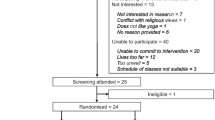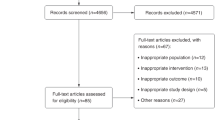Abstract
To describe the role of breathing exercises or yoga and/or pranayama in the management of childhood asthma. We conducted an updated literature search and retrieved relevant literature on the role of breathing exercises or yoga and/or pranayama in the management of childhood asthma. We found that the breathing exercises or yoga and/or pranayama are generally multi-component packaged interventions, and are described as follows: Papworth technique, Buteyko technique, Yoga and/or Pranayam. These techniques primarily modify the pattern of breathing to reduce hyperventilation resulting in normalisation of CO2 level, reduction of bronchospasm and resulting breathlessness. In addition they also change the behaviour, decrease anxiety, improve immunological parameters, and improve endurance of the respiratory muscles that may ultimately help asthmatic children. We found 10 clinical trials conducted in children with asthma of varying severity, and found to benefit children with chronic (mild and moderate) and uncontrolled asthma, but not acute severe asthma. Breathing exercises or yoga and/or pranayama may benefit children with chronic (mild and moderate) and uncontrolled asthma, but not acute severe asthma. Before these techniques can be incorporated into the standard care of asthmatic children, important outcomes like quality of life, medication use, and patient reported outcomes need to be evaluated in future clinical trials.
Similar content being viewed by others
References
Global Initiative for Asthma. Global strategy for asthma management and prevention. 2015. Available at: www.ginasthma.com. Accessed 26 May 2017.
Das RR, Naik SS, Singh M. Probiotics as additives on therapy in allergic airway diseases: a systematic review of benefits and risks. Biomed Res Int. 2013;2013:231979. https://doi.org/10.1155/2013/231979.
Hon KL, Fung CK, Leung AK, Leung TN, Ng DK. Complementary and alternative medicine for childhood asthma: an overview of evidence and patents. Recent Patents Inflamm Allergy Drug Discov. 2015;9:66–79.
Singh M, Das RR, Kumar L, Kumar R. Bacille Calmette-Guérin vaccination is associated with lower prevalence of allergic diseases in Indian children. Am J Rhinol Allergy. 2013;27:e107–12.
Welsh EJ, Hasan M, Li P. Home-based educational interventions for children with asthma. Cochrane Database Syst Rev. 2011;10:CD008469.
Partridge MR, Dockrell M, Smith NM. The use of complementary medicines by those with asthma. Respir Med. 2003;97:436–8.
Shaw A, Thompson EA, Sharp D. Complementary therapy use by patients and parents of children with asthma and the implications for NHS care: a qualitative study. BMC Health Serv Res. 2006;6:76.
Holloway EA. The role of the physiotherapist in the treatment of hyperventilation. In: Timmon BH, Hornsveld H, Garssen B, editors. Behavioral and Psychological Approaches to Breathing Disorders. New York: Plenom Press; 1994.
Bruton A, Kirby S, Arden-Close E, et al. The BREATHE study: Breathing REtraining for Asthma--Trial of Home Exercises. a protocol summary of a randomised controlled trial. Prim Care Respir J. 2013;22:PS1–7.
Bowler SD, Green A, Mitchell CA. Buteyko breathing techniques in asthma: a blinded randomised controlled trial. Med J Aust. 1998;169:575–8.
Elnaggara RK, Shendy MA. Efficacy of noninvasive respiratory techniques in the treatment of children with bronchial asthma: a randomized controlled trial. Bull Facul Phy Ther. 2016;21:1–10.
Asher MI, Douglas C, Airy M, Andrews D, Trenholme A. Effects of chest physical therapy on lung function in children recovering from acute severe asthma. Pediatr Pulmonol. 1990;9:146–51.
El-Helaly N, Aboel-magd MF. Ventilatory functions response to breathing training versus aerobic training in asthmatic children. Egypt J Pediatr Allergy Immunol. 2012;10:33–7.
Karakoç GB, Yilmaz M, Sur S, Altintas DU, Sarpel T, Kendirli SG. The effects of daily pulmonary rehabilitation program at home on childhood asthma. Allergol Immunopathol. 2000;28:12–4.
Lima EV, Lima WL, Nobre A, dos Santos AM, Brito LM, Costa Mdo R. Inspiratory muscle training and respiratory exercises in children with asthma. [Treinamento muscular inspiratório e exercícios respiratórios em crianças asmáticas]. J Bras Pneumol. 2008;34:552–8.
Sakshi MNK. Comparison of breathing exercises and aerobic exercise in asthmatic children. J Exercise Sci Physiother. 2010;6:112–9.
Gupta M, Jit S, Kaur P. Effectiveness of selected Yoga postures and procedures for improvement in pulmonary functions in 8-14 year old children of nasobronchial allergy. Int J Med Res Rev. 2017;5:149–55.
Jasrotia RB, Kanchan A. Effect of yoga on pulmonary functions in asthmatic children. Int J Life Sci Educat Res. 2013;1:110–4.
Azab ASR, Moawd SA, Abdul-Rahman RS. Effect of buteyko breathing exercises versus yoga training on pulmonary functions and functional capacity in children with bronchial asthma: a randomized controlled trial. Int J Therap Rehab Res. 2017;6:148–53.
Tahan F, Gungor HE, Bicici E. Is yoga training beneficial for exercise-induced bronchoconstriction? Altern Ther Health Med. 2014;20:18–23.
John DM. Integrative medicine and asthma. Pediatr Clin N Am. 2007;54:1007–23.
Bruton A, Holgate TS. Hypocapnia and asthma: a mechanism for breathing retraining? Chest. 2005;127:1808–11.
Macêdo TM, Freitas DA, Chaves GS, Holloway EA, Mendonça KM. Breathing exercises for children with asthma. Cochrane Database Syst Rev. 2016;4:CD011017.
Ritz T, Roth WT. Behavioral interventions in asthma. Breathing training. Behav Modif. 2003;27:710–30.
Kosmas EN, Milic-Emili J, Polychronaki A, et al. Exercise-induced flow limitation, dynamic hyperinflation and exercise capacity in patients with bronchial asthma. Eur Respir J. 2004;24:378–84.
Chinnakkannan SK, Singh M, Das RR, Mathew JL, Saxena AK. Association of allergic rhinitis and sinusitis with childhood asthma. Indian Pediatr. 2016;54:21–4.
Kairaitis K, Garlick SR, Wheatley JR, et al. Route of breathing in patients with asthma. Chest. 1999;116:1646–52.
Petruson B, Theman K. Reduced nocturnal asthma by improved nasal breathing. Acta Otolaryngol. 1996;116:490–2.
Chowdhary R, Singh V, Tattersfield AE, et al. Relationship of flow and cross-sectional area to frictional stress in airway models of asthma. J Asthma. 1999;36:419–26.
McIlwaine M. Physiotherapy and airway clearance techniques and devices. Paediatr Respir Rev. 2006;7:S220–2.
Courtney R, Cohen M. Investigating the claims of Konstantin Buteyko: the relationship of breath holding time to end tidal CO2 and other proposed measures of dysfunctional breathing. J Altern Complement Med. 2008;14:115–23.
Jiwtode MT, Rathod VR. Effect of integrated yoga module on respiratory pressures and pulmonary functions in children. Int J Res Med Sci. 2015;3:3548–52.
Acknowledgements
The authors are very much thankful to Dr. Nishant P Jaiswal, Scientist C, ICMR Advanced Centre for Evidence Based Child Health, PGIMER, Chandigarh, India for providing help in the database search.
Author information
Authors and Affiliations
Contributions
JS was involved in designing the protocol for the review, reviewing the literature, statistical analysis and in writing of the manuscript. RRD was involved in reviewing the literature, data extraction, statistical analyses and in writing the paper. Both authors approved the final version of the manuscript. JS will act as the guarantor of the manuscript.
Corresponding author
Ethics declarations
Conflict of Interest
None.
Source of Funding
None.
Electronic supplementary material
ESM 1
(DOCX 98 kb)
Rights and permissions
About this article
Cite this article
Sankar, J., Das, R.R. Asthma – A Disease of How We Breathe: Role of Breathing Exercises and Pranayam. Indian J Pediatr 85, 905–910 (2018). https://doi.org/10.1007/s12098-017-2519-6
Received:
Accepted:
Published:
Issue Date:
DOI: https://doi.org/10.1007/s12098-017-2519-6




